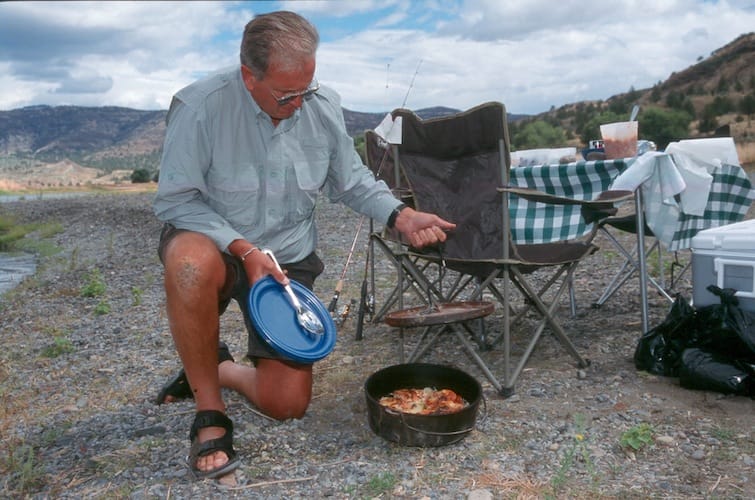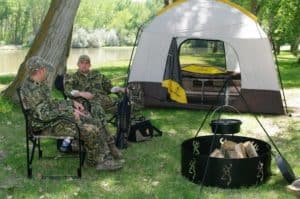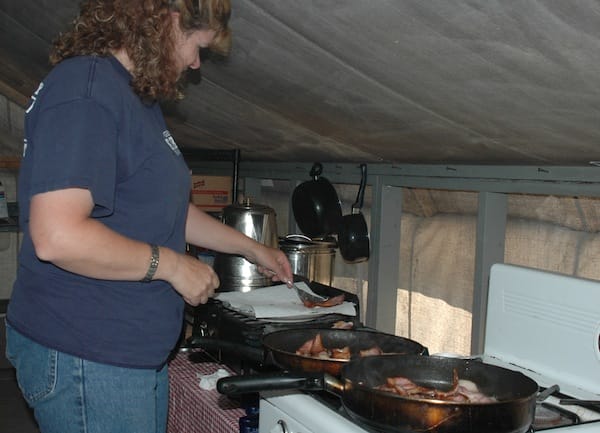by M.D. Johnson
Anyone who has ever spent a night under the stars knows exactly what I’m talking about when I say there’s just something about a meal cooked around a campfire.

Any meal tastes better when cooked while camping along a lake or stream or while making your temporary home deep in the woods.
The tent pitched in the background, and an old school Coleman lantern hissing from its perch on the overhead branch… the camp setting can transform even the worst dining experience into a one-of-a-kind culinary masterpiece. Okay, so maybe it doesn’t work exceptionally well with beets or lima beans, but darn near everything else.
Cooking outdoors, or camp cooking, is often intimidating, especially to those new inductees to the Tribe of the Tent.
In the absence of a traditional stove, oven, and, heaven forbid, a microwave, novice outdoor chefs can find themselves at a loss as to where to begin. And from there, where to proceed.
The truth is when it comes to cooking in the great outdoors, nothing could be less complicated, more informal, and, when it comes time to plop down fireside in that camouflage folding chair, more impressive on the palette.
The Gear
So, what do you need to get started on the road to becoming a great camp cook? Truthfully, the gear list here can either be as simple or as complex as one wishes. However, newbie camp chefs will want to keep simplicity in mind when it comes to selecting cooking equipment. Why? Well, weight for one thing. Camping, and tent camping in particular, is all about making use of limited space and keeping weight to a minimum. Ask yourself, “Do I have to carry this a long distance?” So, keep your camp kitchen simple.
Raised in the mountains of Washington state, my wife Julie has been camping—and cooking outdoors—for more than 40 years. Organization and the aforementioned simplicity are paramount, she says, when it comes to establishing an outdoor kitchen, and then running it efficiently.
“The first thing you have to decide is whether you’re going to cook on an open fire, or use some type of portable cookstove,” she said. “Using a cookstove is easier, as you don’t have to continually maintain or start a suitable fire. Propane heat is there immediately upon demand.
“I know,” she continued, “it’s not as traditional as is cooking on an open fire, but my goal when teaching people about cooking outdoors is to get them started successfully. And a small cookstove powered by propane is a great way to do just that.”
An Organized, Planned Camp
A little planning goes a long way toward a successful camping trip—and it goes ever farther is you want to eat like a king in the middle of nowhere.
“I pack everything I need to transform nothing into a working kitchen in just two red milk crates. I take a pair of Griswold cast iron skillets and a flat lid to fit both, cooking utensils include spatulas, tongs, long-handled fork and large spoons,” Julie said. “Two Tupperware tubs hold eating utensils and spices. And keep the spices simple. Salt, pepper and garlic is all you’ll need. Then I have bowls, dish soap, aluminum foil and several Ziplock bags of different sizes. Once the crates are unpacked, I turn them on their sides, open end facing me, and use them as functional cupboards while I cook. Organization breeds efficiency. You don’t need a lot of stuff to make a great meal, especially outdoors.”
The Groceries
“Let’s be honest,” Julie said with a smile. “I’m frugal when it comes to groceries. Most camp cooks are. The groceries don’t have to be expensive or fancy in order to make a great meal. Nor does the process need to be time-consuming.”
To that end, she prepares many of her outdoor meals in advance of a camping trip. Soups, stews and chili are prepared and cooked, packed in heavy Ziplock freezer bags, and then frozen for reheating afield.
“This serves two purposes,” she said. “One, these homemade recipes make for a great lunch or dinner, especially when it’s chilly. And two, they help keep the other perishable items in the coolers cold until I need them. It cuts down on the mess and expense of ice.”
When camping outdoors, breakfast is THE meal of the day.
“Everyone loves a good breakfast, and it gets people started the right way,” Julie said. “I keep it simple—bacon, eggs, potatoes—but I don’t let it get boring. Omelets are quick, easy and well-received. A few peppers, onions, sliced sausage and ham, and you’ve got a great one-course meal. Pancakes, too. I always have pancake batter and syrup.”
Prepared at home, breakfast burritos—flour tortillas filled will scrambled eggs, sausage, peppers, onions, cheese and her homemade zucchini salsa—are frozen and reheated in tinfoil sleeves, either on the stove or at the edge of the fire.
“If you’re adventurous and hitting the road,” Julie said, “wedge three or four foil-wrapped burritos against the engine block of your truck. By the time you get to the hunt site or fishing hole, they’re hot and ready.”
There’s nothing better than fresh trout—gilled, gutted, sprinkled inside and out with salt and pepper and wrapped in bacon—broiled to perfection in a smoking hot cast iron skillet. Or a brace of ruffed grouse dressed, seasoned, wrapped tight in aluminum foil and nestled in the red-hot coals of a carefully-constructed campfire. Pancakes… burritos… tacos… a venison roast. Heck, even Spam ‘n eggs. It all tastes better—no, it tastes perfect—when prepared in Mother Nature’s kitchen we all know as the great outdoors.
The Union Sportsmen’s Alliance website is designed to provide valuable articles about hunting, fishing and conservation for members of AFL-CIO affiliated labor unions and all sportsmen and sportswomen who appreciate hunting and fishing and want to preserve our outdoor heritage for future generations. If you would like your own story and experience from the outdoors to be considered for our website, please email us at USAmembers@unionsportsmen.org.





